Affiliate disclosure: This post may contain affiliate links. Please see our Privacy Policy.
Planting sprouted potatoes is an easy way to grow potatoes, from potatoes! Once potatoes get sprouty, they’re not great for eating but they’re perfect for planting and it’s surprisingly easy to grow your own fresh new potatoes at home in just a few weeks.
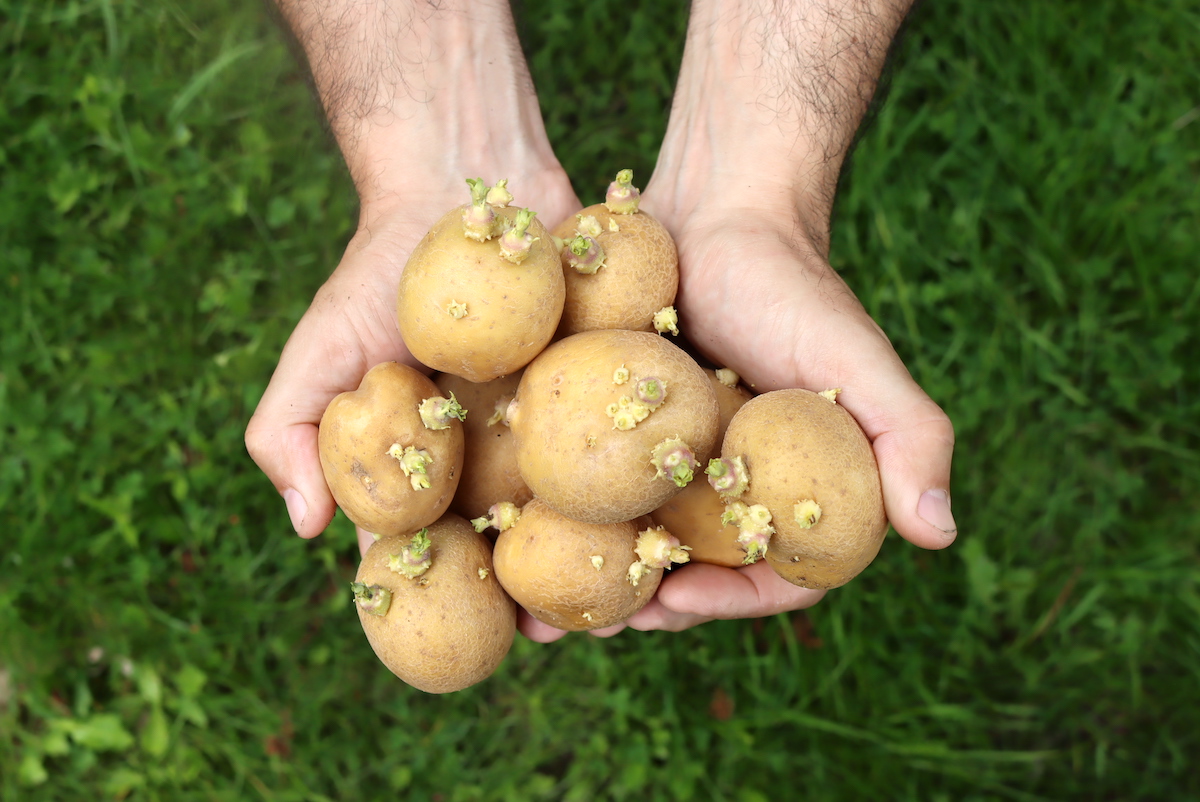
Table of Contents
- Planting Sprouted Potatoes
- When Can You Plant Sprouted Potatoes?
- Where to Plant Sprouted Potatoes
- How Long Should Potato Sprouts Be Before Planting?
- Do You Plant Potatoes with Sprouts Up or Down?
- Do You Have To Cut Sprouted Potatoes Before Planting?
- How Deep Do You Plant Sprouted Potatoes?
- How Far Apart Do You Plant Sprouted Potatoes?
- Do You Have to Hill Potato Plants?
- How Long Do Potato Plants take to Grow?
- Potato Pests
- How to Harvest Potatoes
- Growing Guides
It’s happened to everyone, you forget a few potatoes in the pantry and they start to get green and sprouty. Once potatoes start to sprout, they actually start to produce toxins in their skin that are not great for your digestive system, so eating sprouted potatoes is not the best option.
Throwing them out or composting them seems a shame when with just a tiny bit of effort (and a small amount of soil), you can grow fresh new potatoes from old sprouty potatoes. You don’t need a green thumb, and potatoes actually thrive on relatively poor soil and benign neglect.
It’s actually only a tiny bit more complicated than sticking the potatoes in soil and waiting.
You can plant them, wait a few weeks and harvest tender “new potatoes,” or wait the full season and harvest a whole crop of full-grown regular storage potatoes.
New potatoes are quick, but generally, only yield about 2 to 5 pounds of small tender potatoes per pound planted. Full-season potatoes will usually yield around 15 to 20 pounds of potatoes per pound planted.
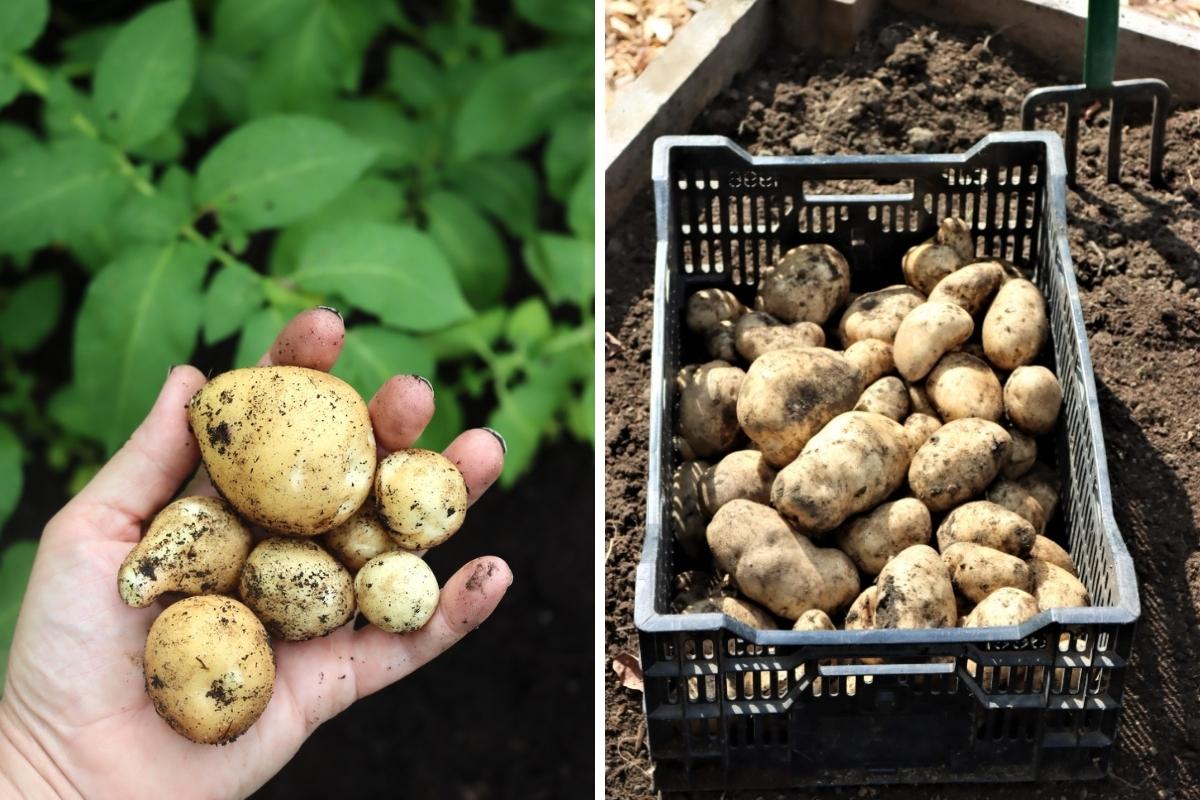
Planting Sprouted Potatoes
Unlike planting sprouted onions or planting sprouted garlic, the process for planting sprouted potatoes isn’t all that different from growing potatoes in general. We tend to grow potatoes in raised beds, but they also do fine straight in the soil. Many people choose to plant sprouted potatoes in containers, and they do well in large pots and in grow bags.
That said, if you’re looking up how to plant sprouted potatoes, there’s a good chance you haven’t grown potatoes before and you have a lot of questions about the process.
Here’s the quick answer:
Plant sprouted potatoes in full sun to part shade, in average garden soil, about 6 to 8” deep and 12 to 16” apart. I don’t bother cutting them, just plant them whole. They can be planted as early as 4 weeks before the last frost in spring, or as late as 8 weeks before the first winter frost. Sprouts should be facing up.
For small tender new potatoes, allow them to grow at least 8 weeks, until the plants set flowers.
For full-sized storage potatoes, allow them to grow all season long until the plants die back. That’s usually 60 to 100 days after planting, depending on the variety. Harvest the potatoes after the plants have been dead for about 2 weeks (they develop their skins for storage after the plants die back).
That’s just the quick answer, and if you want more details, I’ll walk you through the process, one question at a time.
When Can You Plant Sprouted Potatoes?
Generally, potatoes are planted in the spring, about 4 weeks BEFORE the last frost date in your area. That’s 4 weeks before you’d put out your tender garden crops like tomatoes and peppers. They take a while to sprout up out of the soil, and during that time they’re insulated in the earth.
Four weeks before the last frost is about 2 weeks before the first spring dandelions.
That’s the earliest you can plant potatoes outdoors, and that’s ideal if you grow the potatoes all summer and get the maximum yield of full-grown potatoes.
You can, however, plant potatoes anytime during the summer and even into early Autumn, provided you have at least 8 weeks until things turn cool and you get your first hard winter frosts.
Eight weeks will only yield very small new potatoes, and you’ll get just a bit more than the weight you originally planted. Not bad, given that new potatoes are a real treat, and those old sprouty potatoes were going to the compost heap anyway.
If you do plant them in the early spring, as I did, they’ll pop up about 2 weeks later, right alongside your dandelions (still a few weeks before the last frost). They can handle those last few touches of frost in spring, provided they’re mild.
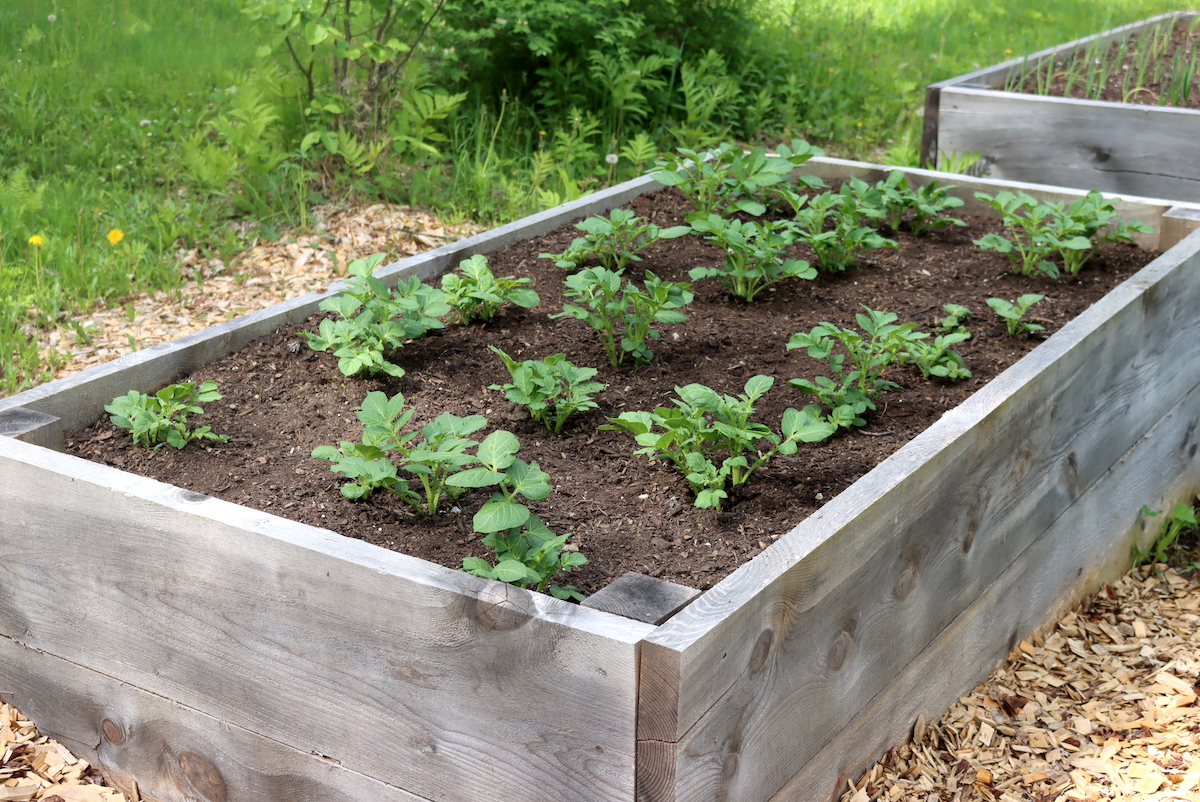
Where to Plant Sprouted Potatoes
Our raised beds are part of our permaculture plantings, and they’re interspersed with fruit trees, raspberry canes, and all manner of other edibles. It’s never exactly full sun, but potatoes don’t really mind. They do find in full sun or part shade, so don’t worry if you’re growing on a back patio.
They’ll do fine anywhere that has full sun to part shade, provided deep soil that’s about average quality. You don’t want rich garden soil, and too much compost will actually cause potatoes to rot. I’m not talking about incredibly poor soil or gravel either, but just average dirt works great for potatoes.
You do need well-drained soil, or a pot or bucket with good drainage. They won’t tolerate wet soils or standing water. Just make sure your pot or grow bag has holes in the bottom so extra water can drain, or you’re planting in average garden soil that doesn’t have standing water.
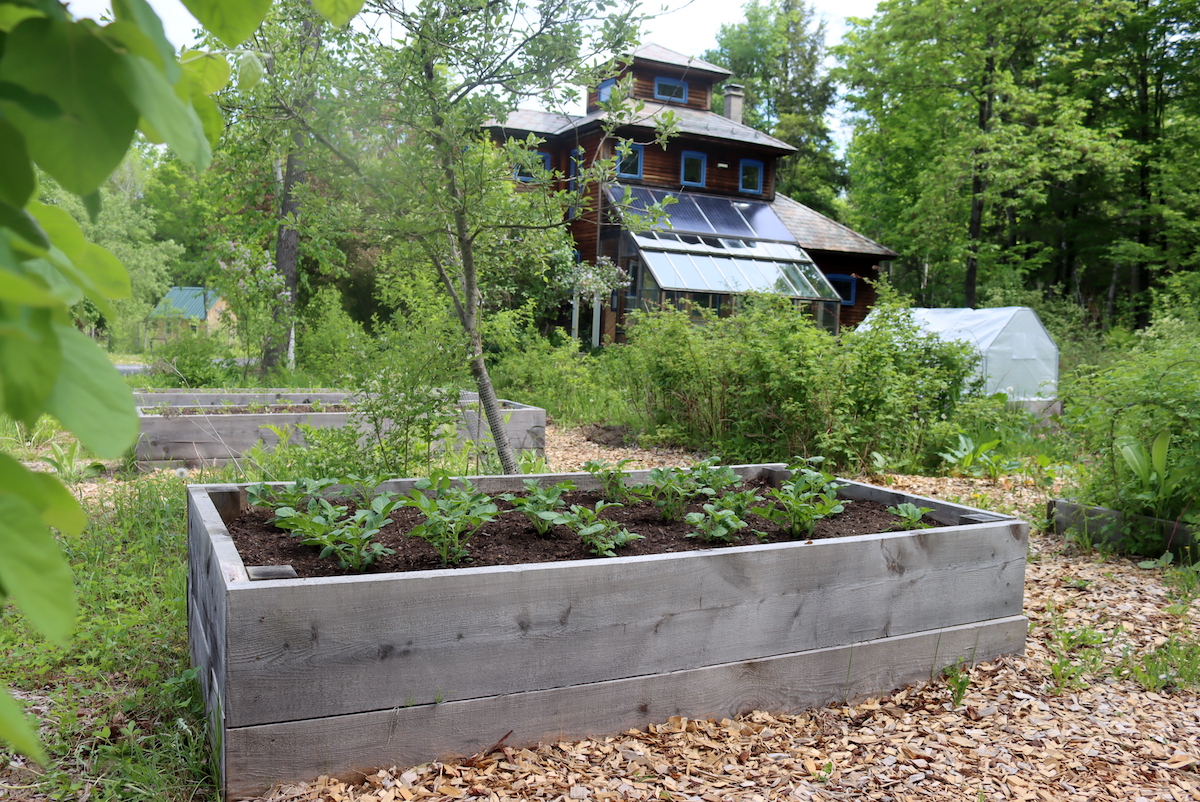
How Long Should Potato Sprouts Be Before Planting?
Once potatoes start to sprout, do you have to wait until they’re a certain length before planting? Nope.
As soon as they sprout, even just teeny tiny sprouts, you can plant potatoes. Most people just break off those teeny tiny sprouts that are only 1 or 2 millimeters long and still eat those potatoes for dinner, but they’re good for planting too.
Once sprouts reach about 1/4 inch or more, the potatoes are really producing toxins that aren’t great for eating, so that’s when I’d suggest consigning your sprouted potatoes to planting rather than eating.
If left a really long time, potato sprouts can really go crazy, and I have found potatoes that rolled out of the storage bin and ended up with sprouts about a foot long!
Those are also still fine for planting, just be very careful with those delicate long sprouts. The potato has already put a lot of work into growing that plant material, and if you break it off it’ll lose that energy (and dramatically lower yields).
Do You Plant Potatoes with Sprouts Up or Down?
Potato sprouts are the leafy portion of the plant, not the roots, so in an ideal world, you’d plant them with the sprouts facing up.
Potatoes tend to sprout from all sides, and they will just figure it out no matter what direction you plant them. If you have small sprouts, just put them in the ground, they’ll be fine.
If you have really long sprouts that are really delicate, lay those in a trench horizontally and gently bury them so you don’t break them. They’ll send vertical shoots up off that long sprout and you’ll get a better yield that way since potatoes will grow all along the original sprout line you laid down.
Do You Have To Cut Sprouted Potatoes Before Planting?
You do not have to cut potatoes before planting, but you can if you want to.
The main reason to cut potatoes before planting is to get more plants from fewer seed potatoes. Commercial growers cut the potatoes into pieces that each have 2 eyes (sprouts) each, and then plant those. They’ll each develop into a potato plant.
If you do cut them, place them cut side down and sprout (or eye) side up when planting.
Personally, I don’t bother cutting the sprouted potatoes before planting because usually, I’m already struggling to find enough garden space to plant these volunteers. I didn’t mean to have sprouted potatoes, they just happen!
I’m happy to get them in the ground and get something for my effort, but I usually don’t have a lot of space for more plants than is strictly necessary.
Leaving the potatoes whole means that the plants have more energy reserves to start with, and they’ll grow faster and more vigorously early in the season. It may hurt your “full season” yield, but you’ll do better if you’re just growing short-season new potatoes for early harvest when they’re small (or if you planted later than early spring).
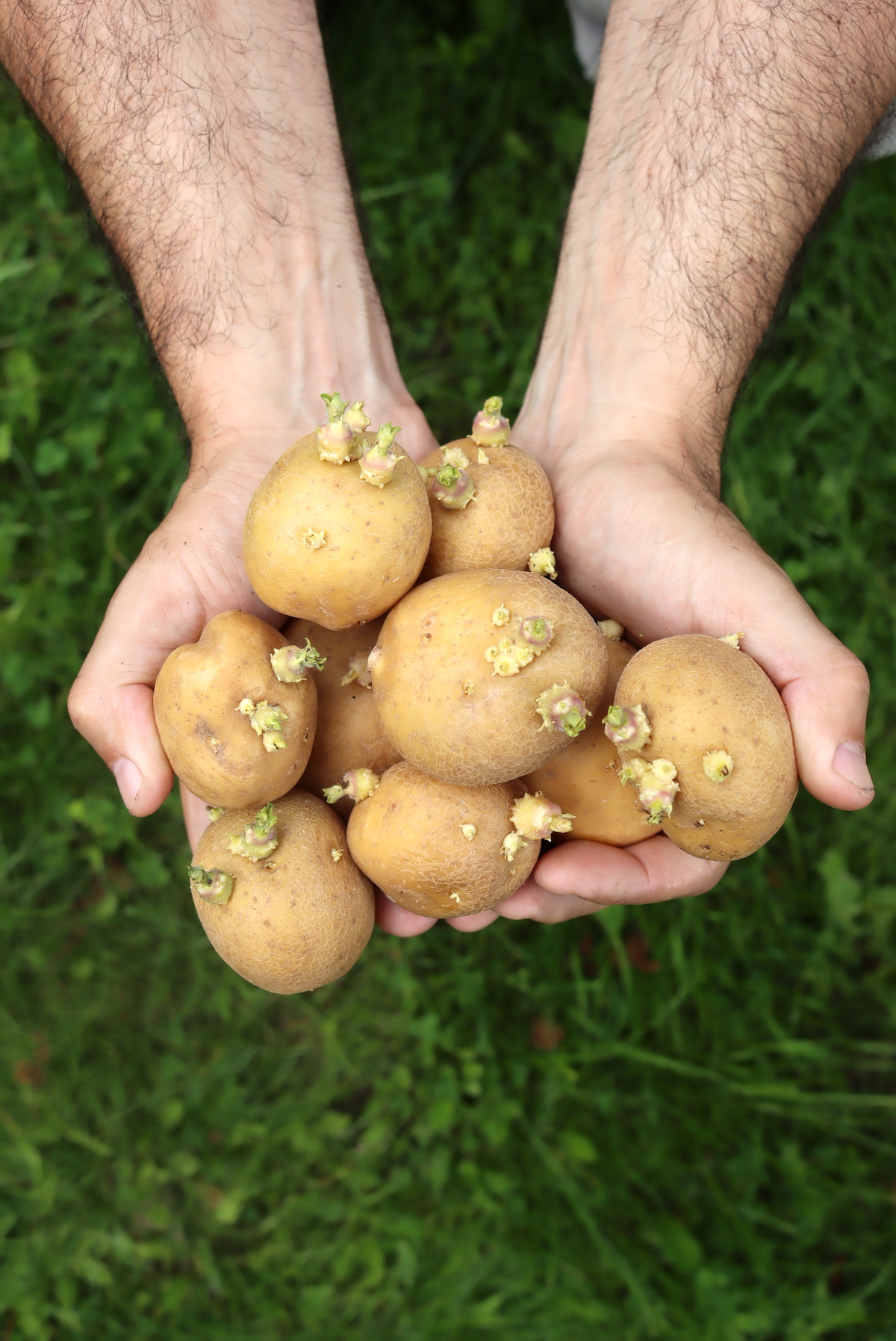
How Deep Do You Plant Sprouted Potatoes?
Generally, potatoes are planted 6 to 8 inches deep. If you’re working with pots or grow bags, try to plant them as deep as you can, while still leaving 2 to 3” of soil beneath the potato.
How Far Apart Do You Plant Sprouted Potatoes?
They’re planted about 12 to 16 inches apart, in rows 2 to 3 feet apart. If you’re planting a “patch” rather than rows, you can just plant them 16” apart in all directions.
Do You Have to Hill Potato Plants?
Technically, you don’t actually have to hill potato plants, and hilling doesn’t even help all types of potatoes.
A bit of background on this…potatoes are actually enlarged parts of the stem of a potato plant. In theory, the more “stem” that gets buried, the more likely the plants are to produce potatoes along the stem.
At least that’s true of some potato varieties. Many common potato varieties these days are what’s known as determinate potatoes, which means they grow quickly and only produce potatoes at or below the depth where the original potato was planted.
They’re a lot easier to tend on a commercial level that way, and easier to harvest since they’re all at one depth.
Determinate potatoes include most fingerlings, and common yellow or golden potatoes, like Yukon gold. Hilling makes absolutely no difference for these varieties, and they’ll grow and produce in around 70 to 80 days regardless.
Some potatoes are known as “indeterminate” and they’ll produce slightly better crops if they’re hilled because they will continue to set potatoes up their stem. Still, even with indeterminate potatoes, hilling is optional and they’ll still produce just fine if left alone.
With those, you can continue to burry them stem every few weeks, leaving about 6 to 12” of plant material exposed above the soil line at all times. They can be hilled with soil, or you can “hill” them by burring them in other material like straw, and they’ll set potatoes right in the straw!
Indeterminate potatoes tend to be super long season potatoes, usually needing 100 to 135 days to mature. (Some types of russet potatoes are indeterminate.)
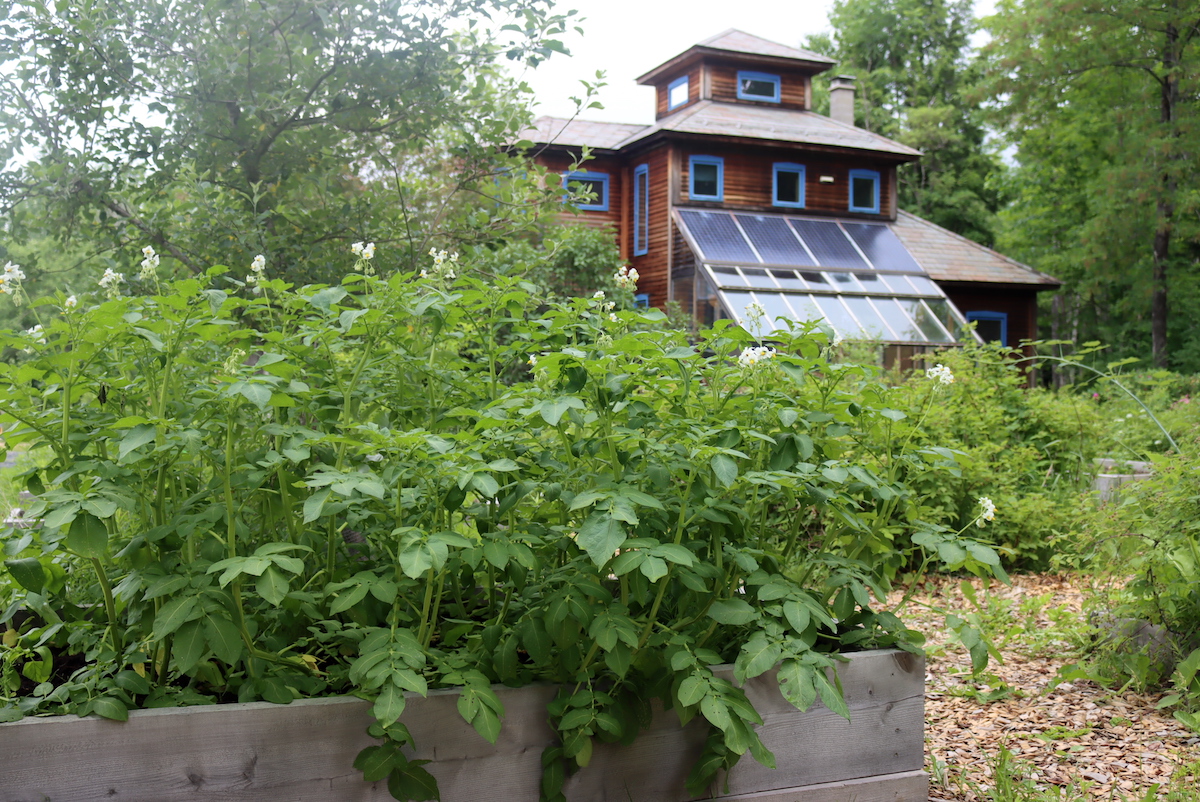
How Long Do Potato Plants take to Grow?
Potatoes are a flexible crop, and you can actually harvest the potatoes at any point during the development of the plant.
The actual official “time to maturity” depends on the variety, which you’re not likely to know for sure if it’s just a generic grocery store sprouted potato. Smaller, early-season potatoes and fingerlings tend to mature in the 60 to 80-day range, while longer-season storage potatoes tend to take 80 to 135 days.
That’s just the time until the plant is fully mature, stops producing, and dies back.
In the meantime, you can harvest potatoes as soon as they develop, and you’ll be able to pull very young tender, “new potatoes” at around 8 weeks after planting.
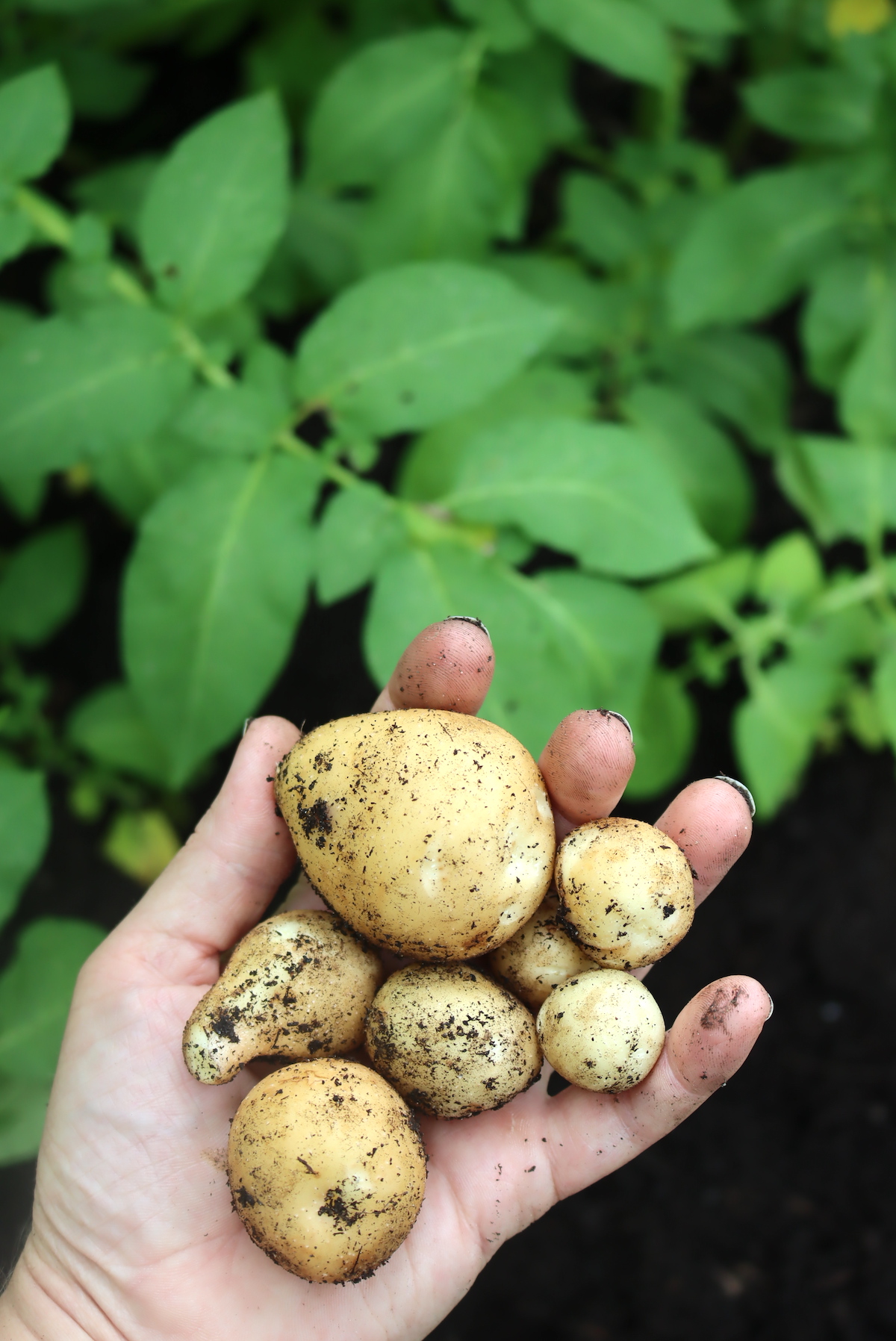
Know that as soon as you harvest, you’re digging up the plant and it won’t produce any more potatoes. (Yes, you can try to re-plant it, but once dug up, they might “live” technically, but they rarely recover to produce further.)
After planting, the potatoes will take about 2 weeks to sprout through at the soil level. Each potato that you planted should have a few sprouts breaking the soil all in a cluster, one from each “eye” on the original potato.
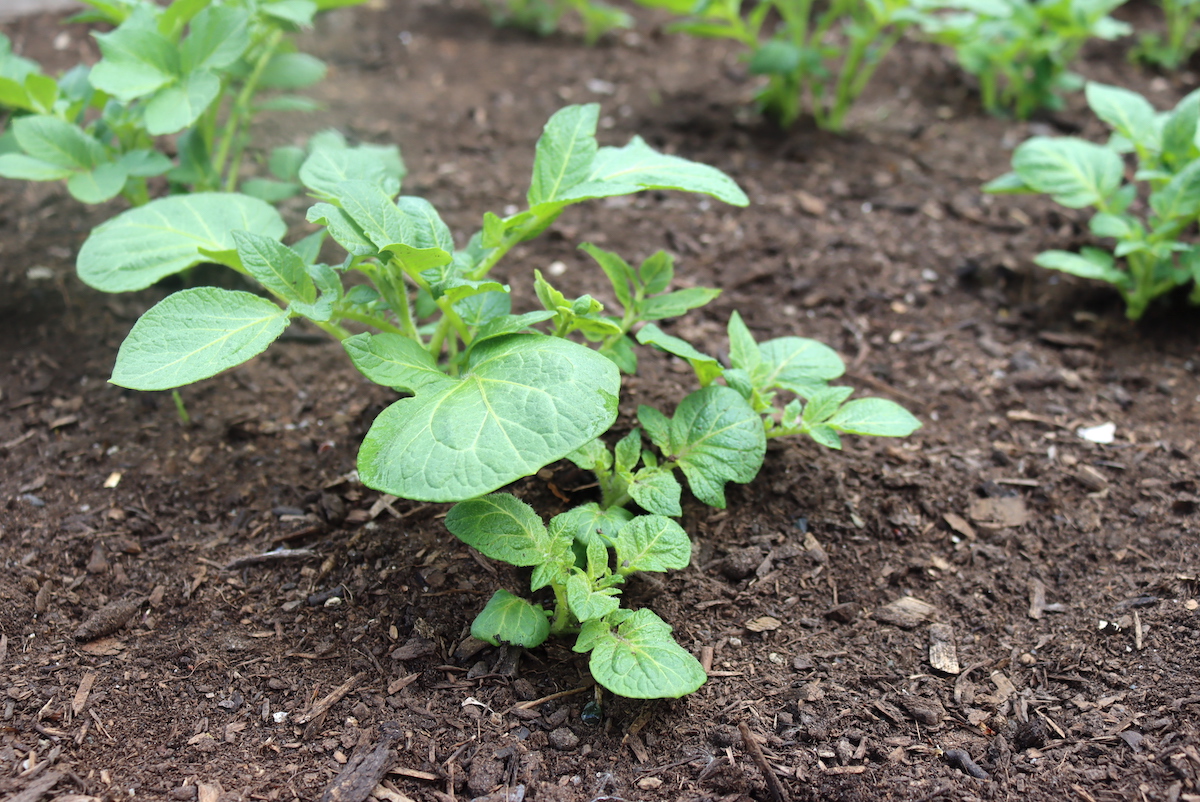
Over the next 6 to 8 weeks, the potato plants will grow rapidly. They should be 16 to 24” tall in just a month or two, and you’ll be amazed at how sturdy and vigorous the plants are without much care.
At that point, they’ll set flowers.
Once the potatoes set flowers, they’ve also set their first small potatoes underground.
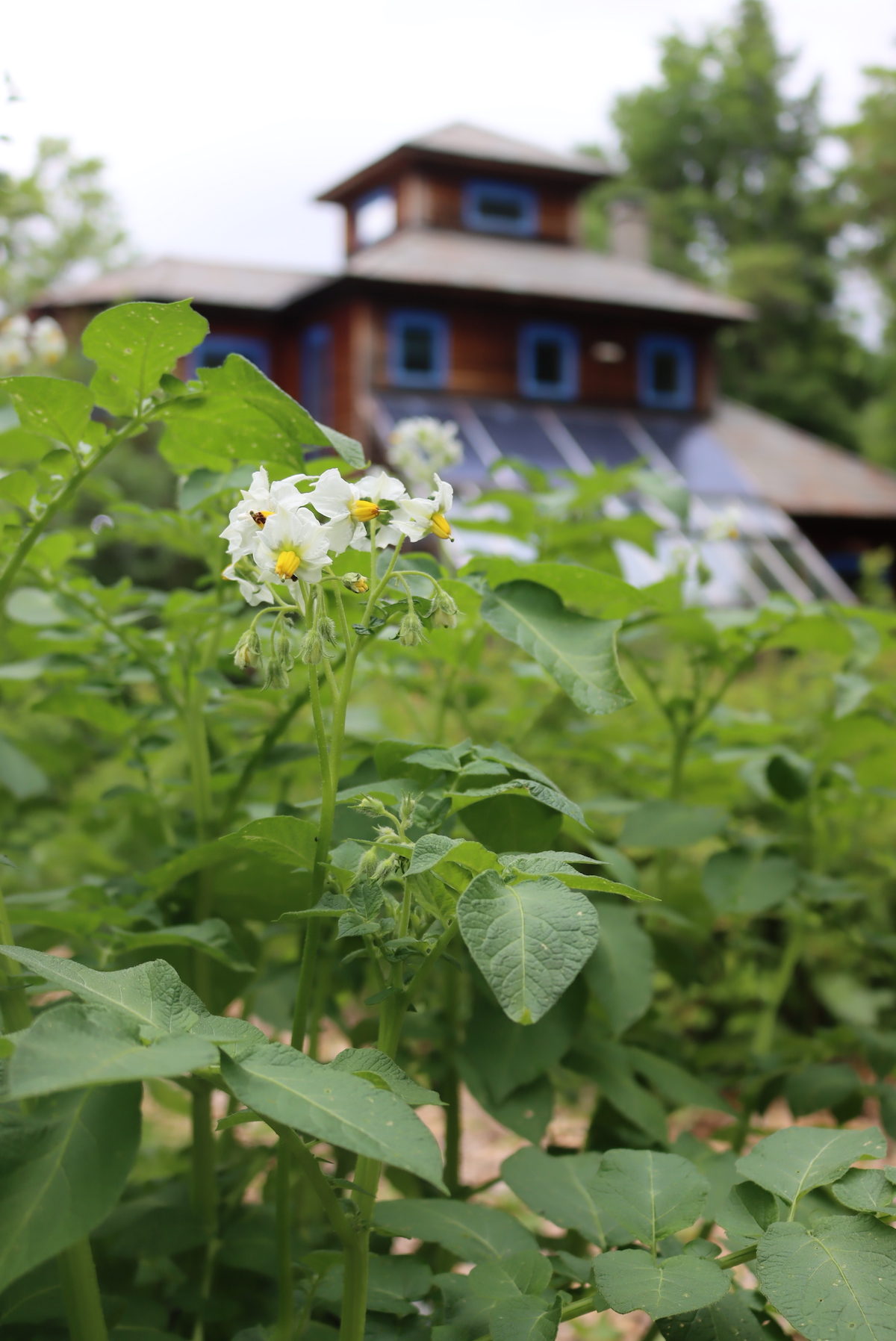
That’s when you can pull your first harvest. At this point, the potatoes will be quite small and you’ll see many completely immature “pin-sized” potential potatoes under there too.
At the “new potato” stage, you should expect to harvest around 2 to 4 times the amount you originally planted.
Past that, the potatoes will continue to grow and develop and your potential harvests will get bigger every week until the plants die back at the end of the season.
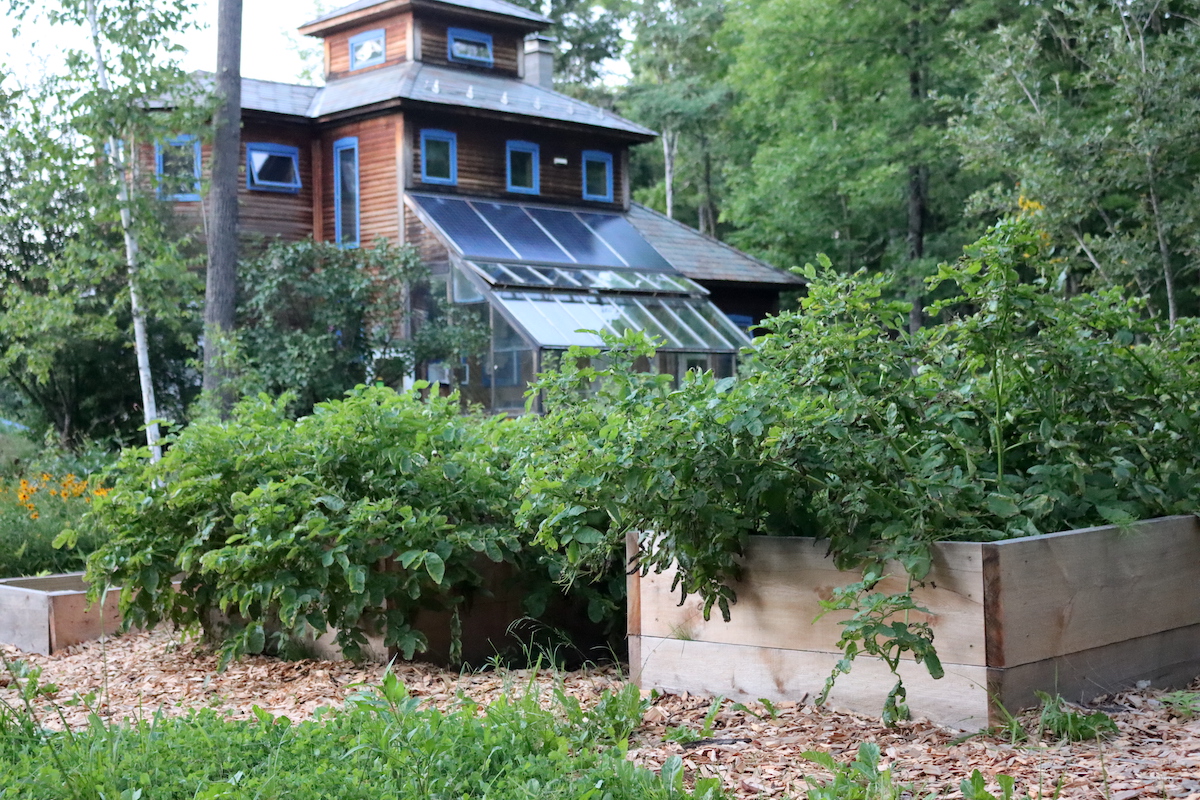
Potato Pests
Potatoes are generally pretty carefree, with the exception of potato bugs (Colorado Potato Beetle). Keep an eye out!
The young beetle larvae are soft-bodied and a red/brown color, with a line of black dots down their sides. Once mature, they have yellow and black striped bodies and orange heads.
These little beasties can quickly defoliate potato plants and they’ll absolutely decimate a harvest. It’s amazing how quickly they can find a single potato plant growing in a pot on your back deck, so don’t think your plants are safe just because they’re not on a “farm.”
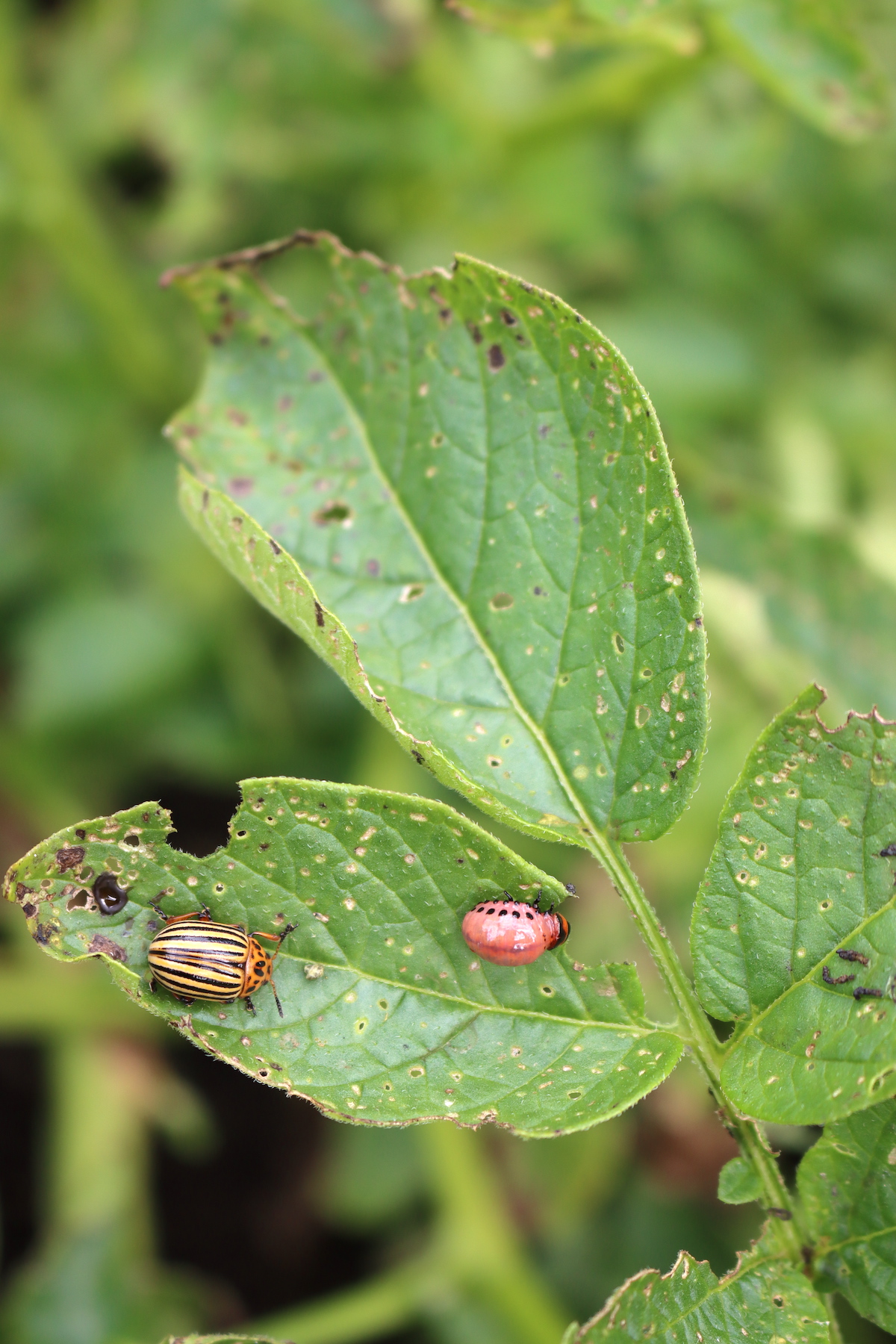
The best treatment is gently picking them off by hand, one by one. They’re about the size of a dime, so it’s not like they’re hard to spot.
When picking off Colorado Potato Beetle, most people carry around a container full of either hydrogen peroxide or just a bit of tap water with a small amount of dish soap in it. Just drop them into the container as you go, and be sure to check the plants daily.
(I’m generally not inclined to spray pesticides on my land, but in this case, they wouldn’t even help. Colorado Potato Beetle has been sprayed commercially so many times that most of the beetles are resistant to just about every pesticide out there. Hand-picking is not just the best option, it’s the only effective option open to home gardeners.)
How to Harvest Potatoes
Potatoes can be harvested starting about 8 weeks after planting, right after the potatoes set flowers. Harvests can continue up until about 2 weeks after the plants die back completely at the end of the growing season.
When you choose to harvest will determine your yields, and harvesting later in the season means more potatoes.
To harvest potatoes, carefully dig around each plant to remove the potatoes from the soil. In most cases, the potatoes will be at or a few inches below the original planting depth. Potatoes tend to spread out laterally, so look about 12 to 16” in all directions from the parent plant.
When I say carefully dig, I don’t mean so that you can re-plant the parent plant. Once dug, it won’t continue to produce. The main reason to be careful is to avoid damaging the potatoes as you harvest them.
Potatoes can be cut by a shovel, but they can also be bruised, just like apples.
Try to get them all, of course, but any left in the soil will grow new plants in a few weeks, which isn’t exactly a bad thing. If it’s late in the season, they’ll wait until next spring to sprout. I have beds that have been growing potatoes for 3 seasons straight now, all from volunteers.
Not bad from a few old sprouty potatoes in the pantry!
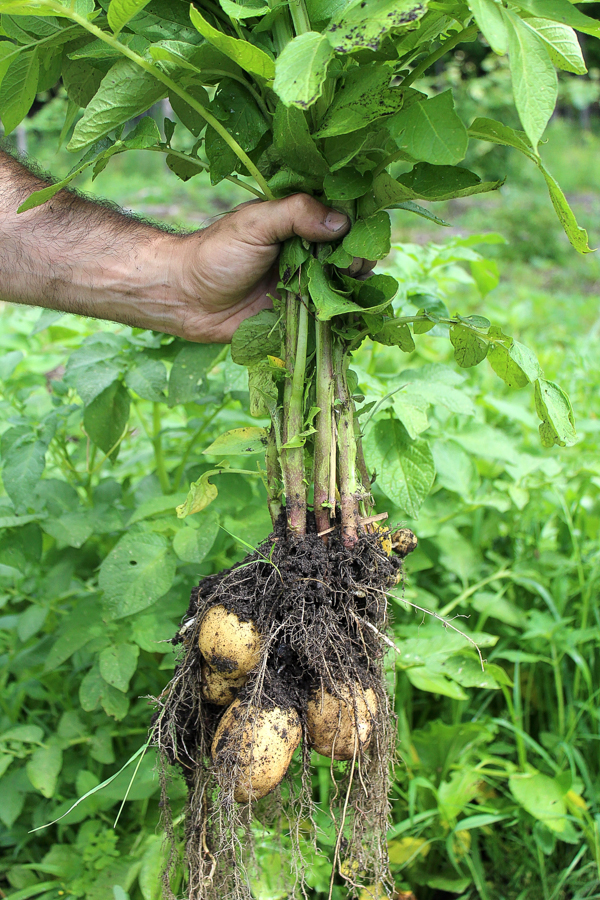
Growing Guides
Looking for more ways to keep your garden growing this season?
- How to Grow Pineberries
- How to Grow Cucamelons
- How to Grow Tomatillos
- How to Grow Calendula
- How to Grow Lemon Balm
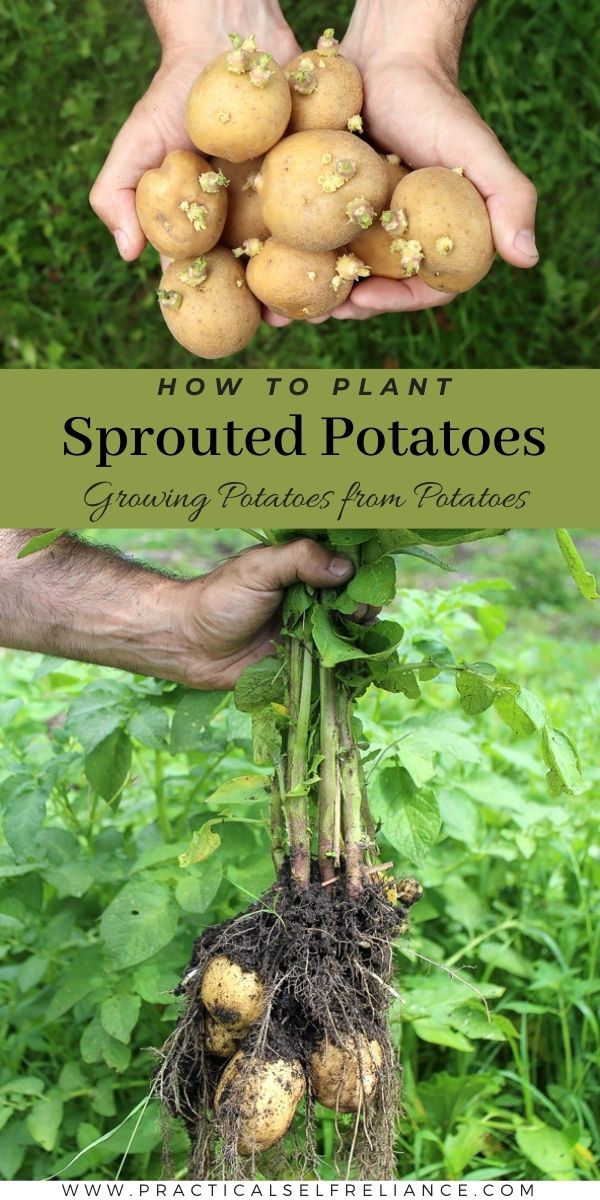




THIS IS THWE MOST COMPREHENSIVE ARTICLE I HAVE EVER READ FROM PLANTING TO HARVESTING POTATOES…TWO THUMBS UP.
Thank you for such a useful post! It really helped this Aussie gardener.
You’re very welcome. We’re so glad it was helpful.
How often should I water my planted potatoes ?
You want to maintain even moisture with 1 to 2 inches of water per week.
What if my potatoes haven’t sprouted, yet? Should I just go ahead and plant them? If so, should I do it differently, like just a couple inches under? I want/need to use a bag(probably an old feed bag – I’m not buying anything I can scrounge!). Will they benefit from some nicely aged goat manure?
It is helpful to pre-sprout your potatoes to get them off to a good start. Here is a complete article on growing potatoes. Let us know if you have any other questions. https://practicalselfreliance.com/grow-potatoes/
I read that we shouldn’t use potatoes from the store. Is that true even if they are organic? I bought seed potatoes but would like to not waste the store bought either.
There are some cautions about using store bought potatoes. Seed potatoes are usually tested and guaranteed to be free from disease and store bought potatoes are not. Lots of people plant them without issue but others prefer not to risk infecting the soil with diseased potatoes.
Thanks for sharing, Ashley.
I’ve been starting my potatoes this way for the last couple of years and have some more to get out here shortly.
I always get a pretty decent crop at the end of the growing season and no complaints for not needing to go out and buy seed potatoes.
I’m thankful haven’t had any issues so far with those beetle bugs. I pray I never do!
You’re welcome. So glad you enjoyed the post.